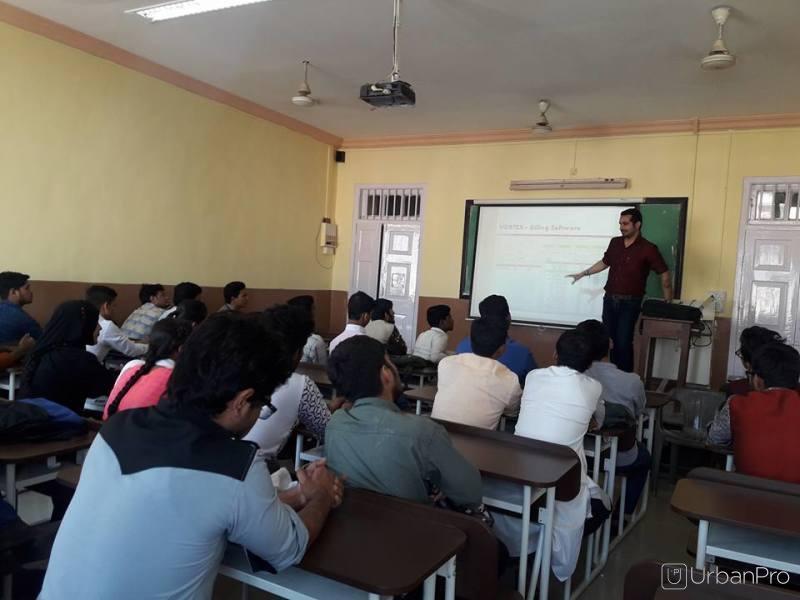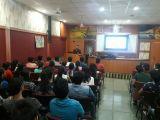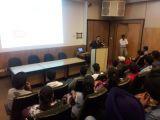
Mahim, Mumbai, India - 400016.
Details verified of Rohan Wasudeo✕
 Identity
Identity
 Education
Education
Know how UrbanPro verifies Tutor details
Identity is verified based on matching the details uploaded by the Tutor with government databases.



Hindi
Marathi
English
![]() Mumbai 2004
Mumbai 2004
Bachelor of Science (B.Sc.)
Mahim, Mumbai, India - 400016
![]() Phone Verified
Phone Verified
![]() Email Verified
Email Verified
Report this Profile
Is this listing inaccurate or duplicate? Any other problem?
Please tell us about the problem and we will fix it.
Class Location
![]() Online (video chat via skype, google hangout etc)
Online (video chat via skype, google hangout etc)
![]() Student's Home
Student's Home
![]() Tutor's Home
Tutor's Home
Years of Experience in HTML Training
2
Class Location
![]() Online (video chat via skype, google hangout etc)
Online (video chat via skype, google hangout etc)
![]() Student's Home
Student's Home
![]() Tutor's Home
Tutor's Home
Years of Experience in Java Training Classes
2
Teaches
Servlet, Struts, JSP (Java Server Pages), Hibernate, J2EE, Core Java, Web services, Spring
Certification training offered
Yes
Class Location
![]() Online (video chat via skype, google hangout etc)
Online (video chat via skype, google hangout etc)
![]() Student's Home
Student's Home
![]() Tutor's Home
Tutor's Home
Years of Experience in Mobile App Development Training
10
Teaches following
Hybrid Application Development
Teaching Experience in detail in Mobile App Development Training
With 15+ years of industry experience in development and having passionately about coding really love to guide and mentor aspiring coders and learners. I believe practice makes a man / woman perfect hence believe in less of theoretical and more of practicals and assignments in my training sessions. Being a coder myself my training approach basically is in the terms of real world applications. I have mentored more then thousands of students which include college students and working professionals and all set to mentor and guide more students. My goal is to create amazing developers accross the world. Remember learning is a collaborative effort. Together we will create an environment that nurtures intellectual curiosity and fosters meaningful connections.
1. Which classes do you teach?
I teach HTML, Java Training and Mobile App Development Classes.
2. Do you provide a demo class?
Yes, I provide a free demo class.
3. How many years of experience do you have?
I have been teaching for 2 years.
What is Web designing? The term Web designing circumscribes around production and maintanance of a website. It covers different areas such as Interface design or often called as User Interface, the code...
Answered on 22 Apr Learn IT Courses/Web Designing
Hi Nagesh,
Here is the answer to your question
Yes, there are different types of web design, each with its own focus, style, and purpose. Here are some common types of web design:
Responsive Web Design: Responsive web design focuses on creating websites that adapt and respond to different screen sizes and devices, providing an optimal viewing experience for users across desktops, laptops, tablets, and smartphones. This approach ensures that the layout, content, and design elements adjust dynamically to fit the screen size, orientation, and resolution, improving usability and accessibility.
Flat Design: Flat design is a minimalist design approach that emphasizes simplicity, clarity, and clean aesthetics. It features flat, two-dimensional elements, simple typography, vibrant colors, and minimal use of shadows or gradients. Flat design prioritizes usability and content readability, making it popular for modern websites, mobile apps, and user interfaces.
Material Design: Material design is a design language developed by Google that combines principles of flat design with tactile and physical interactions. It uses depth, motion, and shadow effects to create a sense of hierarchy, structure, and realism in digital interfaces. Material design emphasizes responsive animations, intuitive navigation, and consistent design patterns across different platforms and devices.
Minimalist Design: Minimalist design focuses on simplicity, clarity, and functionality by removing unnecessary elements and distractions. It emphasizes whitespace, clean typography, and simple layouts to create a visually pleasing and clutter-free user experience. Minimalist design is often used for portfolios, blogs, and websites that prioritize content and storytelling.
Typography-Centric Design: Typography-centric design puts a strong emphasis on typography as a central design element. It uses creative typography, custom fonts, and expressive text treatments to convey the brand's personality, evoke emotions, and guide the user's attention. Typography-centric design often combines bold headlines, elegant typefaces, and creative text layouts to create visually striking and memorable experiences.
Illustrative Design: Illustrative design incorporates custom illustrations, graphics, and visual storytelling to enhance the website's aesthetics and convey complex ideas or messages. It uses hand-drawn illustrations, vector graphics, and animations to add personality, creativity, and interactivity to the website. Illustrative design is popular for websites targeting creative industries, children's brands, or businesses with unique brand identities.
These are just a few examples of web design styles, and many websites may incorporate elements from multiple design styles to create a unique and engaging user experience. The choice of web design style depends on the project requirements, target audience, branding guidelines, and the desired visual impact.
Answered on 22 Apr Learn IT Courses/Web Designing
Hi Tarun,
To answer your question
Website designing and development is the process of creating and building websites, encompassing various tasks and disciplines to deliver a functional and visually appealing online platform. Here's an overview of the key components:
Designing: This involves conceptualizing the layout, structure, and visual elements of the website. Designers focus on creating an intuitive user experience (UX) and an engaging user interface (UI) using tools like Adobe Photoshop, Sketch, or Figma. They consider aspects such as color schemes, typography, imagery, and branding elements to create a cohesive design that reflects the client's brand identity and resonates with the target audience.
Frontend Development: Frontend developers translate the design into code using languages like HTML, CSS, and JavaScript. They ensure that the website is responsive and accessible across various devices and browsers, implementing techniques like responsive design and progressive enhancement. Frontend developers also integrate interactive elements, animations, and third-party libraries or frameworks like React, Angular, or Vue.js to enhance user interaction and functionality.
Backend Development: Backend developers focus on the server-side logic and functionality of the website. They work with programming languages like Python, PHP, Ruby, or Node.js to create server-side applications, manage databases, handle user authentication, and process data. Backend developers also interact with APIs (Application Programming Interfaces) to integrate external services or functionalities into the website.
Content Management: Content management involves creating, organizing, and managing the content that populates the website. Content management systems (CMS) like WordPress, Joomla, or Drupal provide tools and interfaces for non-technical users to easily update and maintain website content without needing to write code.
Testing and Deployment: Once the website is developed, it undergoes rigorous testing to ensure functionality, usability, and compatibility across different platforms. Testing involves manual and automated testing processes, including functionality testing, usability testing, performance testing, and security testing. After testing, the website is deployed to a live server or hosting environment, making it accessible to users on the internet.
Overall, website designing and development is a collaborative process involving designers, developers, content creators, and project managers working together to create effective and functional websites that meet the needs of clients and users.
Class Location
![]() Online (video chat via skype, google hangout etc)
Online (video chat via skype, google hangout etc)
![]() Student's Home
Student's Home
![]() Tutor's Home
Tutor's Home
Years of Experience in HTML Training
2
Class Location
![]() Online (video chat via skype, google hangout etc)
Online (video chat via skype, google hangout etc)
![]() Student's Home
Student's Home
![]() Tutor's Home
Tutor's Home
Years of Experience in Java Training Classes
2
Teaches
Servlet, Struts, JSP (Java Server Pages), Hibernate, J2EE, Core Java, Web services, Spring
Certification training offered
Yes
Class Location
![]() Online (video chat via skype, google hangout etc)
Online (video chat via skype, google hangout etc)
![]() Student's Home
Student's Home
![]() Tutor's Home
Tutor's Home
Years of Experience in Mobile App Development Training
10
Teaches following
Hybrid Application Development
Teaching Experience in detail in Mobile App Development Training
With 15+ years of industry experience in development and having passionately about coding really love to guide and mentor aspiring coders and learners. I believe practice makes a man / woman perfect hence believe in less of theoretical and more of practicals and assignments in my training sessions. Being a coder myself my training approach basically is in the terms of real world applications. I have mentored more then thousands of students which include college students and working professionals and all set to mentor and guide more students. My goal is to create amazing developers accross the world. Remember learning is a collaborative effort. Together we will create an environment that nurtures intellectual curiosity and fosters meaningful connections.
Answered on 22 Apr Learn IT Courses/Web Designing
Hi Nagesh,
Here is the answer to your question
Yes, there are different types of web design, each with its own focus, style, and purpose. Here are some common types of web design:
Responsive Web Design: Responsive web design focuses on creating websites that adapt and respond to different screen sizes and devices, providing an optimal viewing experience for users across desktops, laptops, tablets, and smartphones. This approach ensures that the layout, content, and design elements adjust dynamically to fit the screen size, orientation, and resolution, improving usability and accessibility.
Flat Design: Flat design is a minimalist design approach that emphasizes simplicity, clarity, and clean aesthetics. It features flat, two-dimensional elements, simple typography, vibrant colors, and minimal use of shadows or gradients. Flat design prioritizes usability and content readability, making it popular for modern websites, mobile apps, and user interfaces.
Material Design: Material design is a design language developed by Google that combines principles of flat design with tactile and physical interactions. It uses depth, motion, and shadow effects to create a sense of hierarchy, structure, and realism in digital interfaces. Material design emphasizes responsive animations, intuitive navigation, and consistent design patterns across different platforms and devices.
Minimalist Design: Minimalist design focuses on simplicity, clarity, and functionality by removing unnecessary elements and distractions. It emphasizes whitespace, clean typography, and simple layouts to create a visually pleasing and clutter-free user experience. Minimalist design is often used for portfolios, blogs, and websites that prioritize content and storytelling.
Typography-Centric Design: Typography-centric design puts a strong emphasis on typography as a central design element. It uses creative typography, custom fonts, and expressive text treatments to convey the brand's personality, evoke emotions, and guide the user's attention. Typography-centric design often combines bold headlines, elegant typefaces, and creative text layouts to create visually striking and memorable experiences.
Illustrative Design: Illustrative design incorporates custom illustrations, graphics, and visual storytelling to enhance the website's aesthetics and convey complex ideas or messages. It uses hand-drawn illustrations, vector graphics, and animations to add personality, creativity, and interactivity to the website. Illustrative design is popular for websites targeting creative industries, children's brands, or businesses with unique brand identities.
These are just a few examples of web design styles, and many websites may incorporate elements from multiple design styles to create a unique and engaging user experience. The choice of web design style depends on the project requirements, target audience, branding guidelines, and the desired visual impact.
Answered on 22 Apr Learn IT Courses/Web Designing
Hi Tarun,
To answer your question
Website designing and development is the process of creating and building websites, encompassing various tasks and disciplines to deliver a functional and visually appealing online platform. Here's an overview of the key components:
Designing: This involves conceptualizing the layout, structure, and visual elements of the website. Designers focus on creating an intuitive user experience (UX) and an engaging user interface (UI) using tools like Adobe Photoshop, Sketch, or Figma. They consider aspects such as color schemes, typography, imagery, and branding elements to create a cohesive design that reflects the client's brand identity and resonates with the target audience.
Frontend Development: Frontend developers translate the design into code using languages like HTML, CSS, and JavaScript. They ensure that the website is responsive and accessible across various devices and browsers, implementing techniques like responsive design and progressive enhancement. Frontend developers also integrate interactive elements, animations, and third-party libraries or frameworks like React, Angular, or Vue.js to enhance user interaction and functionality.
Backend Development: Backend developers focus on the server-side logic and functionality of the website. They work with programming languages like Python, PHP, Ruby, or Node.js to create server-side applications, manage databases, handle user authentication, and process data. Backend developers also interact with APIs (Application Programming Interfaces) to integrate external services or functionalities into the website.
Content Management: Content management involves creating, organizing, and managing the content that populates the website. Content management systems (CMS) like WordPress, Joomla, or Drupal provide tools and interfaces for non-technical users to easily update and maintain website content without needing to write code.
Testing and Deployment: Once the website is developed, it undergoes rigorous testing to ensure functionality, usability, and compatibility across different platforms. Testing involves manual and automated testing processes, including functionality testing, usability testing, performance testing, and security testing. After testing, the website is deployed to a live server or hosting environment, making it accessible to users on the internet.
Overall, website designing and development is a collaborative process involving designers, developers, content creators, and project managers working together to create effective and functional websites that meet the needs of clients and users.
What is Web designing? The term Web designing circumscribes around production and maintanance of a website. It covers different areas such as Interface design or often called as User Interface, the code...

Reply to 's review
Enter your reply*
Your reply has been successfully submitted.
Certified
The Certified badge indicates that the Tutor has received good amount of positive feedback from Students.